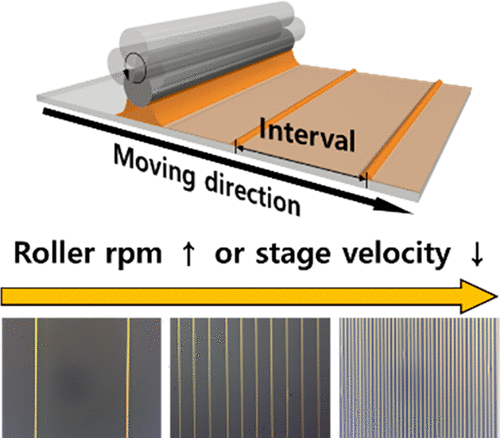Our official English website, www.x-mol.net, welcomes your
feedback! (Note: you will need to create a separate account there.)
High-Speed Production of Crystalline Semiconducting Polymer Line Arrays by Meniscus Oscillation Self-Assembly
ACS Nano ( IF 15.8 ) Pub Date : 2020-11-24 , DOI: 10.1021/acsnano.0c07268 Jisoo Jeon 1, 2 , Alvin T. L. Tan 3 , Jaeyong Lee 4 , Jeong Eun Park 1, 2 , Sukyoung Won 1, 2 , Sanha Kim 3 , Mostafa Bedewy 5 , Jamison Go 3 , Jin Kon Kim 4 , A. John Hart 3 , Jeong Jae Wie 1, 2
ACS Nano ( IF 15.8 ) Pub Date : 2020-11-24 , DOI: 10.1021/acsnano.0c07268 Jisoo Jeon 1, 2 , Alvin T. L. Tan 3 , Jaeyong Lee 4 , Jeong Eun Park 1, 2 , Sukyoung Won 1, 2 , Sanha Kim 3 , Mostafa Bedewy 5 , Jamison Go 3 , Jin Kon Kim 4 , A. John Hart 3 , Jeong Jae Wie 1, 2
Affiliation

|
Evaporative self-assembly of semiconducting polymers is a low-cost route to fabricating micrometer and nanoscale features for use in organic and flexible electronic devices. However, in most cases, rate is limited by the kinetics of solvent evaporation, and it is challenging to achieve uniformity over length- and time-scales that are compelling for manufacturing scale-up. In this study, we report high-throughput, continuous printing of poly(3-hexylthiophene) (P3HT) by a modified doctor blading technique with oscillatory meniscus motion—meniscus-oscillated self-assembly (MOSA), which forms P3HT features ∼100 times faster than previously reported techniques. The meniscus is pinned to a roller, and the oscillatory meniscus motion of the roller generates repetitive cycles of contact-line formation and subsequent slip. The printed P3HT lines demonstrate reproducible and tailorable structures: nanometer scale thickness, micrometer scale width, submillimeter pattern intervals, and millimeter-to-centimeter scale coverage with highly defined boundaries. The line width as well as interval of P3HT patterns can be independently controlled by varying the polymer concentration levels and the rotation rate of the roller. Furthermore, grazing incidence wide-angle X-ray scattering (GIWAXS) reveals that this dynamic meniscus control technique dramatically enhances the crystallinity of P3HT. The MOSA process can potentially be applied to other geometries, and to a wide range of solution-based precursors, and therefore will develop for practical applications in printed electronics.
中文翻译:

弯月面振荡自组装高速生产晶体半导体聚合物线阵列
半导体聚合物的蒸发自组装是制造用于有机和柔性电子设备的微米级和纳米级特征的低成本途径。但是,在大多数情况下,速率受溶剂蒸发动力学的限制,要在规模和时间尺度上实现均一性(这对于制造规模化具有吸引力)具有挑战性。在这项研究中,我们报告了通过改良的刮刀振荡法(弯月振荡自组装(MOSA))改进的刮刀技术,高通量连续印刷聚(3-己基噻吩)(P3HT),形成P3HT的特征约为100次比以前报道的技术更快。弯液面被钉在辊子上,而辊子的振荡弯液面运动会产生接触线形成和随后打滑的重复循环。印刷的P3HT线展示了可重现和可定制的结构:纳米刻度厚度,微米刻度宽度,亚毫米图案间隔以及具有严格定义的边界的毫米到厘米刻度范围。P3HT图案的线宽和间隔可以通过改变聚合物浓度水平和辊的旋转速度来独立控制。此外,掠入射广角X射线散射(GIWAXS)表明,这种动态弯月面控制技术显着提高了P3HT的结晶度。MOSA工艺可以潜在地应用于其他几何形状以及各种基于溶液的前体,因此将在印刷电子中的实际应用中发展。亚毫米图案间隔以及具有高度定义的边界的毫米到厘米刻度范围。P3HT图案的线宽和间隔可以通过改变聚合物浓度水平和辊的旋转速度来独立控制。此外,掠入射广角X射线散射(GIWAXS)表明,这种动态弯月面控制技术显着提高了P3HT的结晶度。MOSA工艺可以潜在地应用于其他几何形状以及各种基于溶液的前体,因此将在印刷电子中的实际应用中发展。亚毫米图案间隔以及具有高度定义的边界的毫米到厘米刻度范围。P3HT图案的线宽和间隔可以通过改变聚合物浓度水平和辊的旋转速度来独立控制。此外,掠入射广角X射线散射(GIWAXS)表明,这种动态弯月面控制技术显着提高了P3HT的结晶度。MOSA工艺可以潜在地应用于其他几何形状以及各种基于溶液的前体,因此将在印刷电子领域的实际应用中发展。P3HT图案的线宽和间隔可以通过改变聚合物浓度水平和辊的旋转速度来独立控制。此外,掠入射广角X射线散射(GIWAXS)表明,这种动态弯月面控制技术显着提高了P3HT的结晶度。MOSA工艺可以潜在地应用于其他几何形状以及各种基于溶液的前体,因此将在印刷电子领域的实际应用中发展。P3HT图案的线宽和间隔可以通过改变聚合物浓度水平和辊的旋转速度来独立控制。此外,掠入射广角X射线散射(GIWAXS)表明,这种动态弯月面控制技术显着提高了P3HT的结晶度。MOSA工艺可以潜在地应用于其他几何形状以及各种基于溶液的前体,因此将在印刷电子领域的实际应用中发展。
更新日期:2020-12-22
中文翻译:

弯月面振荡自组装高速生产晶体半导体聚合物线阵列
半导体聚合物的蒸发自组装是制造用于有机和柔性电子设备的微米级和纳米级特征的低成本途径。但是,在大多数情况下,速率受溶剂蒸发动力学的限制,要在规模和时间尺度上实现均一性(这对于制造规模化具有吸引力)具有挑战性。在这项研究中,我们报告了通过改良的刮刀振荡法(弯月振荡自组装(MOSA))改进的刮刀技术,高通量连续印刷聚(3-己基噻吩)(P3HT),形成P3HT的特征约为100次比以前报道的技术更快。弯液面被钉在辊子上,而辊子的振荡弯液面运动会产生接触线形成和随后打滑的重复循环。印刷的P3HT线展示了可重现和可定制的结构:纳米刻度厚度,微米刻度宽度,亚毫米图案间隔以及具有严格定义的边界的毫米到厘米刻度范围。P3HT图案的线宽和间隔可以通过改变聚合物浓度水平和辊的旋转速度来独立控制。此外,掠入射广角X射线散射(GIWAXS)表明,这种动态弯月面控制技术显着提高了P3HT的结晶度。MOSA工艺可以潜在地应用于其他几何形状以及各种基于溶液的前体,因此将在印刷电子中的实际应用中发展。亚毫米图案间隔以及具有高度定义的边界的毫米到厘米刻度范围。P3HT图案的线宽和间隔可以通过改变聚合物浓度水平和辊的旋转速度来独立控制。此外,掠入射广角X射线散射(GIWAXS)表明,这种动态弯月面控制技术显着提高了P3HT的结晶度。MOSA工艺可以潜在地应用于其他几何形状以及各种基于溶液的前体,因此将在印刷电子中的实际应用中发展。亚毫米图案间隔以及具有高度定义的边界的毫米到厘米刻度范围。P3HT图案的线宽和间隔可以通过改变聚合物浓度水平和辊的旋转速度来独立控制。此外,掠入射广角X射线散射(GIWAXS)表明,这种动态弯月面控制技术显着提高了P3HT的结晶度。MOSA工艺可以潜在地应用于其他几何形状以及各种基于溶液的前体,因此将在印刷电子领域的实际应用中发展。P3HT图案的线宽和间隔可以通过改变聚合物浓度水平和辊的旋转速度来独立控制。此外,掠入射广角X射线散射(GIWAXS)表明,这种动态弯月面控制技术显着提高了P3HT的结晶度。MOSA工艺可以潜在地应用于其他几何形状以及各种基于溶液的前体,因此将在印刷电子领域的实际应用中发展。P3HT图案的线宽和间隔可以通过改变聚合物浓度水平和辊的旋转速度来独立控制。此外,掠入射广角X射线散射(GIWAXS)表明,这种动态弯月面控制技术显着提高了P3HT的结晶度。MOSA工艺可以潜在地应用于其他几何形状以及各种基于溶液的前体,因此将在印刷电子领域的实际应用中发展。









































 京公网安备 11010802027423号
京公网安备 11010802027423号